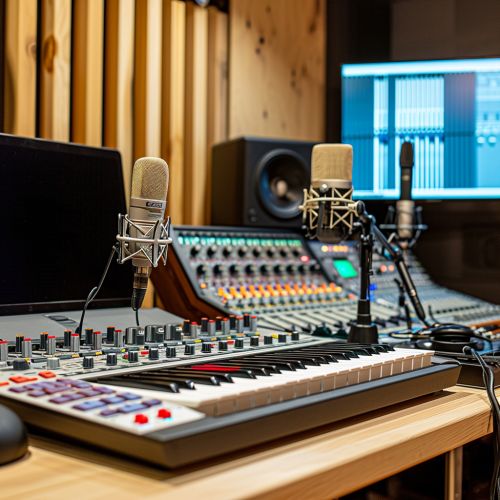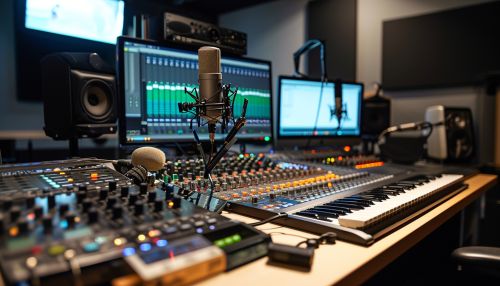Digital Recording
Introduction
Digital recording is a method of preserving audio or video content in a digital format. This process involves the conversion of analog signals into a stream of digital data that can be stored and manipulated electronically. The advent of digital recording has revolutionized the fields of music, television, and film production, offering unprecedented control over the quality and manipulation of recorded sound and visuals.


History
The history of digital recording began in the late 20th century. Prior to this, all recording was done using analog technologies, which capture continuous signals and store them in a physical medium such as magnetic tape or vinyl records. The first digital audio recording systems were developed in the 1970s by companies like Sony Corporation and Philips Electronics. These early systems used large, expensive hardware and were primarily used in professional recording studios.
In the 1980s, the introduction of the Compact Disc (CD) brought digital audio to the consumer market. CDs offered superior sound quality compared to vinyl records and cassette tapes, and they were more durable and easier to produce. This led to a rapid adoption of digital audio in the music industry.
The development of digital video recording followed a similar trajectory. The first digital video recorders were introduced in the late 1980s and early 1990s by companies like Panasonic Corporation and Sony Corporation. These early systems were used primarily in professional video production, but by the late 1990s, digital video cameras had become affordable for consumers.
Principles of Digital Recording
Digital recording works by converting analog signals into digital data. This is done through a process called sampling, in which the analog signal is measured at regular intervals. Each measurement is then converted into a binary number, which can be stored and manipulated electronically.
The quality of a digital recording is determined by two factors: the sampling rate and the bit depth. The sampling rate is the number of times per second that the analog signal is measured. The bit depth is the number of bits used to represent each measurement. Higher sampling rates and bit depths result in higher-quality recordings, but they also require more storage space.
Digital recordings can be manipulated using digital signal processing techniques. These techniques allow for a wide range of effects, including equalization, compression, and reverb. They can also be used to remove unwanted noise or to enhance certain aspects of the recording.
Advantages and Disadvantages
Digital recording offers several advantages over analog recording. First, digital recordings are not subject to the same physical degradation as analog recordings. Over time, analog recordings can suffer from noise, distortion, and loss of fidelity due to wear and tear on the physical medium. Digital recordings, on the other hand, can be copied and transferred without any loss of quality.
Second, digital recording allows for greater control over the recording process. With digital signal processing, it is possible to manipulate the sound in ways that are not possible with analog techniques. This has opened up new possibilities for creativity and experimentation in music and film production.
However, digital recording also has its disadvantages. Some critics argue that digital recordings lack the warmth and character of analog recordings. This is due to the fact that digital recording involves a process of quantization, which can result in a loss of detail in the recorded signal. Additionally, the process of converting analog signals into digital data can introduce artifacts and distortions, particularly if the sampling rate and bit depth are not high enough.
Applications
Digital recording is used in a wide range of applications, from music and film production to scientific research. In the music industry, digital recording has become the standard method of recording and producing music. It allows for a high level of control over the sound, and it enables artists to experiment with new sounds and techniques.
In film and television production, digital recording is used to capture both sound and visuals. Digital video cameras offer a number of advantages over traditional film cameras, including the ability to instantly review footage and the ability to shoot in low-light conditions. Digital audio recording is used to capture dialogue, sound effects, and music.
In scientific research, digital recording is used to capture and analyze data. For example, in the field of acoustics, digital recording is used to capture and analyze sound waves. In the field of astronomy, digital recording is used to capture and analyze data from telescopes.
Future Trends
The field of digital recording continues to evolve, with new technologies and techniques being developed all the time. One of the most significant trends in recent years has been the move towards higher-resolution audio and video. This includes the development of high-definition video formats like 4K and 8K, as well as high-resolution audio formats like 24-bit/192kHz.
Another important trend is the increasing use of cloud-based storage and processing for digital recordings. This allows for greater flexibility and scalability, as well as the ability to access and manipulate recordings from any location.
Finally, the field of digital recording is being shaped by advances in artificial intelligence and machine learning. These technologies are being used to develop new tools and techniques for recording and processing digital audio and video, opening up new possibilities for creativity and innovation.
